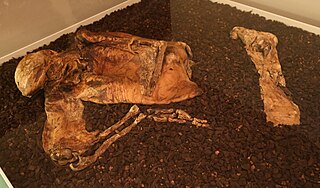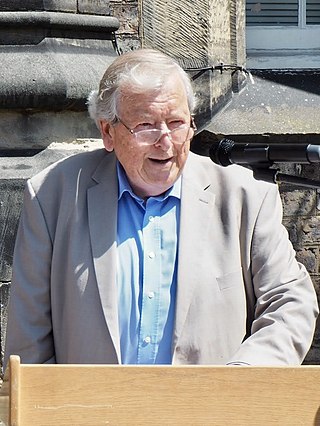Awards
| | This section is empty. You can help by adding to it. (July 2010) |
| |||
|---|---|---|---|
| +... |
The year 1984 in archaeology involved some significant events.
| | This section is empty. You can help by adding to it. (July 2010) |

Lindow Man, also known as Lindow II and as Pete Marsh, is the preserved bog body of a man discovered in a peat bog at Lindow Moss near Wilmslow in Cheshire, North West England. The remains were found on 1 August 1984 by commercial peat cutters. Lindow Man is not the only bog body to have been found in the moss; Lindow Woman was discovered the year before, and other body parts have also been recovered. The find was described as "one of the most significant archaeological discoveries of the 1980s" and caused a media sensation. It helped invigorate study of British bog bodies, which had previously been neglected.

Maritime archaeology is a discipline within archaeology as a whole that specifically studies human interaction with the sea, lakes and rivers through the study of associated physical remains, be they vessels, shore-side facilities, port-related structures, cargoes, human remains and submerged landscapes. A specialty within maritime archaeology is nautical archaeology, which studies ship construction and use.

Cape Gelidonya, formerly Kilidonia or Killidonia is a cape or headland on the Teke Peninsula in the chain of Taurus Mountains, located on the southern coast of Anatolia between the Gulf of Antalya and the Bay of Finike.

Scandinavian York or Viking York is a term used by historians for what is now Yorkshire during the period of Scandinavian domination from late 9th century until it was annexed and integrated into England after the Norman Conquest; in particular, it is used to refer to York, the city controlled by these kings and earls. The Kingdom of Jórvíc was closely associated with the much longer-lived Kingdom of Dublin throughout this period.

The Uluburun Shipwreck is a Late Bronze Age shipwreck dated to the late 14th century BC, discovered close to the east shore of Uluburun, Turkey, in the Mediterranean Sea. The shipwreck was discovered in the summer of 1982 by Mehmed Çakir, a local sponge diver from Yalıkavak, a village near Bodrum.

Bodrum Castle is a historical fortification located in southwest Turkey in the port city of Bodrum, built from 1402 onwards, by the Knights of St John as the Castle of St. Peter or Petronium. A transnational effort, it has four towers known as the English, French, German, and Italian towers, bearing the names of the nations responsible for their construction. The chapel was built around 1407 and the first walls completed in 1437. The castle started reconstruction in the late 14th century, only to be taken over by the Islamic Ottoman Empire in 1523. The chapel was converted to a mosque, and a minaret was added. The castle remained under the empire for almost 400 years. After remaining empty following World War I, in the early 1960s, the castle became the home for the Bodrum Museum of Underwater Archaeology. In 2016 it was inscribed in the UNESCO Tentative list of World Heritage Sites in Turkey.

Slapton is a village and civil parish in the South Hams district of Devon, England. It is located near the A379 road between Kingsbridge and Dartmouth, and lies within the South Devon Area of Outstanding Natural Beauty (AONB). The nearby beach is Slapton Sands; despite its name, it is not a sandy beach but a shingle one.
The year 1985 in archaeology involved some significant events.

The Lloyds Bank coprolite is a large coprolite, or fossilised specimen of human faeces, recovered by the York Archaeological Trust while excavating the Viking settlement of Jórvík in northern England.

The York Archaeological Trust for Excavation and Research Limited (YAT) is an educational charity, established in 1972 in the city of York, England. It carries out archaeological investigations, fieldwork, excavation and research in York, Yorkshire and throughout Britain and beyond. Its staff include specialists in archaeological excavation, historic building analysis and recording, artefact curation, conservation and research, archaeological computing, and illustration and design.
David Gibbins is an underwater archaeologist and a bestselling novelist.
The year 1982 in archaeology involved some significant events.

The Jorvik Viking Centre is a museum and visitor attraction in York, England, containing lifelike mannequins and life-size dioramas depicting Viking life in the city. Visitors are taken through the dioramas in small carriages equipped with speakers. It was created by the York Archaeological Trust and opened in 1984. Its name is derived from Jórvík, the Old Norse name for York and the surrounding Viking Kingdom of Yorkshire.
The year 2007 in archaeology

Coppergate Shopping Centre is a shopping centre in York in North Yorkshire, England. It is named after Coppergate, one of York's medieval streets.

Peter Vincent Addyman,, known as P. V. Addyman, is a British archaeologist, who was Director of the York Archaeological Trust from 1972 to 2002. Addyman obtained a degree in archaeology at Cambridge University, after which he lectured at Queen's University Belfast and the University of Southampton, while also conducting excavations. In 1972 he was offered the directorship of the newly founded York Archaeological Trust, the creation of which he had proposed; along with excavation work in York, he oversaw the development of the Jorvik Viking Centre, the Archaeological Resource Centre, and Barley Hall. In 2000 he was appointed a Commander of the Order of the British Empire.
This page lists major archaeological events of 2015.
Dominic Tweddle,, is an English archaeologist specialising in Anglo-Saxon studies and the director general of the National Museum of the Royal Navy. Previously he spent time as a research assistant at the British Museum and as the assistant director of the York Archaeological Trust, where he helped develop the Jorvik Viking Centre. He is also an honorary professor at the UCL Institute of Archaeology and the University of Portsmouth.
This page lists major archaeological events of 2018.
This page lists major events of 2019 in archaeology.